It's Admissions Season!
Come visit our campuses or learn more about WSP’s transformative preschool-12th education.
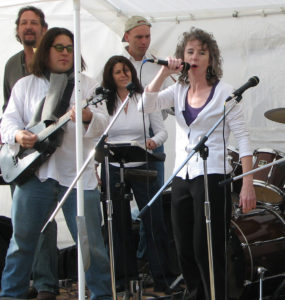
Like many in our community, I could not process Rich Armstrong’s recent passing. After receiving the phone call that morning, I walked around all day feeling like I had been kicked in the stomach. Finding a fitting way to fully articulate him and what he brought to the WSP community is impossible, but I will try.
I blogged about Rich’s influence on my musical life when I released my album in March 2020:
“In addition to a ridiculous measure of musical gifts (to list them would take up this entire blog post), Rich has the most sweeping and genuine gift of encouragement that I have ever experienced, musical or otherwise. Making music himself (his trumpet playing is swoon-worthy) may be the only thing he loves more than teaching and, most importantly, empowering others to make and love music.”
Rich’s passion for music was almost more than his body could hold. I saw him weep more than once with a blazing desire to make music himself and to bring music-making to his students. His prodigious, intensely imaginative and creative mind conjured project after project to utilize and develop the musical chops of those around him.
A middle school rock band, in which my son, Dillon (Schneider 2011), played the drums for three years, held annual concerts with national level music professionals such as Tony Lindsay of Santana – who were all Rich’s friends. The Soul Providers, a dance cover band originally composed of WSP parents, for which I was a lead singer, played for the WSP Gala for three consecutive years. The high school jazz band, the middle school wind ensemble, the most recent manifestation of the high school handbell ensemble, the Holiday Faire brass caroling ensemble, among many others, were all products of his visionary imagination and initiative.
My son once summed up his experience with Rich by saying that Rich treated him like an equal, musically speaking. Rich requested and expected Dillon, even at the tender age of twelve, to rise to the best of his drumming ability, as if nothing was impossible, and as if he had full faith that Dillon could do anything if he tried. Rich was exacting and relentless in his drive to bring his ensembles to a standard that did the music justice, and he had a firm, unshakeable belief that anyone who wanted to could and should not only make music, but make excellent music.
 In the spring of 2009, I had decided never to sing again because of an unfortunate musical experience. That fall, Rich hauled me out of that musical pit when he recruited me as the lead singer of The Soul Providers. Later, he recruited me to go on tour with him, playing cello and singing back-up for Michelle Shocked. Not only did he believe in me and demand that I believe in myself, he reminded me that doing music is fun … insanely so. (photo at left of Rich and author performing with The Soul Providers at the WSP Holiday Faire in 2009)
In the spring of 2009, I had decided never to sing again because of an unfortunate musical experience. That fall, Rich hauled me out of that musical pit when he recruited me as the lead singer of The Soul Providers. Later, he recruited me to go on tour with him, playing cello and singing back-up for Michelle Shocked. Not only did he believe in me and demand that I believe in myself, he reminded me that doing music is fun … insanely so. (photo at left of Rich and author performing with The Soul Providers at the WSP Holiday Faire in 2009)
Now, I have two releases of my original music (an EP and an album) with a new album coming in April 2023. I would absolutely *never* have had the audacity to do any of this without Rich’s direct influence. He was a fanatic for music, and I like to think that some of his intensity rubbed off on me. I know it rubbed off on many of you.
So whatever instrument you may have played with and for Rich, pull it out today and play or sing a song or two in his honor. And maybe do it again tomorrow. And maybe the next day, too. Rich would have liked it that way.
Rich Armstrong was one of the Bay Area’s most sought-after multi-instrumentalists, switching effortlessly between vocals, trumpet, percussion, and guitar. He had a storied career, having played, toured, and recorded with Boz Scaggs, Tony! Toni! Toné!, Thomas Dolby, Lydia Pense & Cold Blood, Lyrics Born, Train, and Josh Groban. He also did stints with Petula Clarke, Spoon, and Jody Watley, and most recently he was touring Europe with Groundation. He was a 15-year band member and musical director for the now infamous but still extremely talented Michelle Shocked, having toured almost every state and country with her.
Rich was the founder and band leader of one of SF’s most elite variety/pop/dance bands, The 415s, which received the “Best of the Bay” award from San Francisco Magazine. He was also a member of SF’s famed Jazz Mafia and a founding member of the Crossroads Live Music Experience that brought high level music to Burning Man for five years running. Rich Armstrong passed away in early October after more than twelve years teaching music at WSP. His daughter Anika is a WSP high school graduate, and his parents Peter and Akiko are long-time members of the WSP community.
Martha Groves Perry is the parent of two WSP high school alumni (Dillon Perry & Bryn Perry), she served on the WSP Board including one term as President, and she worked for WSP as Interim Publications Coordinator, Mountain View Campus Coordinator, and Interim School Administrator. Learn more about her music at marthagrovesperry.com.
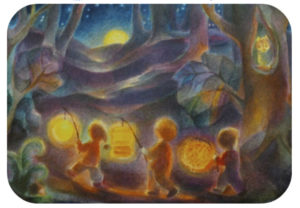
Each little child will bring the light,
‘til all the world is warm and bright.
In many countries the Festivals of Light begin when our days grow short and nights grow long. In North America we first experience the cheery Jack-O-Lantern at Halloween, illuminating the night for a band of wandering cowboys, clowns, pirates, and flower fairies. In Waldorf schools worldwide, the two days following Halloween are set aside for All Soul’s Day in honor of the spirits of those who have died. Then, children take up the light they first kindled at Halloween, and with which they then illuminated the threshold between spheres in remembrance, and on the eve or day of Martinmas — traditionally November 11th, they carry a homemade lantern back out into the world (singing with their families), to their friends, neighbors, and community.
These festivals wonderfully express the spirit of man and nature at this time of year. All Soul’s and Martinmas have the quality of being a good follow-up to Halloween silliness in preparation for the Advent season. The external picture is one of the dying of outward nature; the leaves have fallen, the weather is cold, and the grim part of autumn has cast its spell.
Inwardly, the earth, and also the human being, becomes more spiritually alive. But, there is a danger of withdrawing too much within and cutting off from the rest of the world. The gesture of community of the children snaking their way through the darkness with their lanterns, searching to bring a little light and warmth from within back into the world, where there are those who are cold and hungry living in the darkness, is most fitting — and visually impressive. It is even good if the weather is a little bit on the nasty side. One feels the discomfort and the reality of what it means to be “out in the cold” and the effort it takes to walk through it and carry the lanterns.
At the end of Martinmas we partake of hot cider, soup, or breads with plenty of warmth and stories. The stories about Saint Martin helping the poor beggarman, who then reveals his own sacred nature to the Saint, take on a deeper meaning in this contrasted outdoor/indoor setting of activity. As the children themselves feel the bite of cold and the contrasting warmth of receiving the good food, drink, and soul warming songs and story, they develop the beginnings of the sense of what it really means to both suffer and receive succor: all very subtle, but concrete and real.
November Song
Golden light is turning grey, mists begin to rule the day.
Bare the trees their branches rift, clouds to dead leaves earthward drift.
Through the field the farmer pulls, seeds of ripened corn he sows,
trusts the earth will hold it warm, shelter it from cold and harm.
For he knows that warmth and light live there hidden from our sight,
and beneath a sheltering wing, deep below new life will spring.
Deep below, deep below, new life will spring.
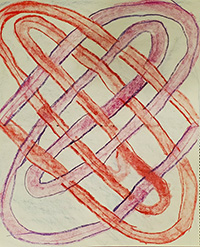
Form drawing is a unique part of Waldorf Education. At Waldorf schools, students mainly practice form drawing from First grade through Fifth grade. As with most subjects, each year brings increasing complexity and new challenges to students’ spatial abilities, fine motor skills and focus, among other things. We can easily recognize how the act of form drawing lays a foundation for writing and drawing. More intriguing is that it also builds visual thinking, anticipatory thinking, spatial thinking, complex-solution thinking, and mathematical thinking.
 So what is form drawing? Simply put, form drawing is the free-hand drawing of variations of the two universal forms – the straight line and the curved line, from which all forms are born – done through “repetitive drawing of symbols and shapes—both linear and lateral, zigzag or congruous knots. This freehand creation of patterns is more about process than product…” (“The Practical and Creative Art of Form Drawing” – Beverly Amico).
So what is form drawing? Simply put, form drawing is the free-hand drawing of variations of the two universal forms – the straight line and the curved line, from which all forms are born – done through “repetitive drawing of symbols and shapes—both linear and lateral, zigzag or congruous knots. This freehand creation of patterns is more about process than product…” (“The Practical and Creative Art of Form Drawing” – Beverly Amico).
As a parent, the most important thing to know about form drawing is that last part: that form drawing is about the process, not the product. This process- how the drawing is done and not just how it looks in the end- is the “form” discussed in this Messenger article. Because it is this exercise of form drawing, like the exercise of any complex physical movement, that develops the brain and character of the student.
Often it is easier for us to see the value in that carefully controlled practice/form when it comes to teaching our child a physical skill, such as a rond de jambe in ballet. We patiently take our children to lessons where they practice a movement over and over until their body and brain are finally able to work fluidly together to create a perfect freestyle swim stroke or a beautifully executed hinge kick.
We forget that smaller movements, such as those of the hand, are also physical movements and that, as physical movements, they also require fluid communication between the brain, the eyes and the hand.
For form drawing, teachers often have the students walk the form, air-draw the form, or even draw the form with their foot on the floor, before they begin to draw the form on paper. During a form drawing exercise, teachers encourage students to draw continuously, without lifting and reorienting the pencil or paper. Students often want to move the paper around on their desk or start and stop a drawing to make it easier and to make it more “perfect.” They want to get the product- the final drawing- “right” as quickly and easily as possible.
This requirement to not move the paper or lift the crayon can seem arbitrary to parents, creating needless frustration for students- it makes getting the drawing “right” easier if you break the drawing into smaller parts or shift the paper around so that the brain has an easier time orienting itself to the image. So why would the teacher discourage the student from doing this?
This would be like a ballet teacher allowing your child to “perfect” their turns by simply walking around in a circle. Sure, they’ve turned 360 degrees, but that is not an actual ballet turn. A student walking their ballet turn hasn’t developed the muscle tone, coordination, balance and brain/body connections that are needed to execute an actual ballet turn. In short, they’ve been deprived of both the physical and mental growth that they would gain by carefully practicing the ballet turn over and over again until they can execute it as fluidly as possible. It may never be “perfect” but they will have gained those strong mental and physical abilities through the practice.
So what might it mean if your child wants to pick up or shift that piece of paper? What do they gain when a teacher does not allow them to “walk their ballet turn” by doing so? It could be a sign that they are struggling with crossing their midline. Crossing the midline is important because it shows that children (and adults) can use “both sides of their brain to coordinate smooth, controlled, complex movement.” (link) Children typically first start crossing their midline when they are 4-6 months old and master the skill when they are 8 or 9 years of age. For this reason, we expect that 1st and 2nd graders will struggle to keep their papers straight and thus have to cross their midline to draw the form. But as adults, we know they need this practice to support healthy brain development. Sometimes that practice, as with occupational therapy exercises, can be frustrating, but the process of doing the exercise- of sticking with the form in form drawing- is key.
When a child struggles to learn something challenging, reassure them that they will get better with practice. Remember that there are plenty of times during the day when they are allowed to start and stop a drawing or move their paper around their desk to avoid crossing that midline. But the form in form drawing is there for a purpose. It’s just another way that Waldorf Education supports the healthy brain development of the growing child.
Curious to know more about the role of form drawing in Waldorf curriculum? Keep reading!
As with everything in Waldorf Education, form drawing is multifunctional in its effects and has many educational benefits. As described by Angela Lord in her book Creative Form Drawing, “The true aim of education is not primarily to gather information for the sake of it, but to awaken genuine capacities of perception, judgment, creativity, and reliability in relation to life and living. Form drawing contributes in a meaningful way to healthy education.” She goes on to discuss that two important benefits of form drawing are integrating sensory experience and spatial awareness.
Form Drawing was brought to Waldorf schools by Rudolf Steiner, who worked with many groups of teachers in the early 1900’s. Steiner believed form drawing was an essential practice for education. “A kind of visual measuring through cognitive feeling is developed in the child by solving such form problems. By completing the other half of a form that the teacher has drawn on the board, the child can find his or her inner balance and a sense of natural harmony.
Rudolf Steiner said in the fourth chapter of The Kingdom of Childhood: ‘In this way [through form drawing] one educates the child toward a real feeling for form, toward a feeling for harmony, for symmetry, and toward a feeling of relationships. In this way one can guide the child into those harmonies which also exist in the world around us.’ And further on he says: ‘…the child will develop on the one hand more thoughtfulness in his observations and on the other hand more intuition in his thinking.’ One could say a kind of moral imagination is introduced through such exercises that insist on the virtue of veracity and visual truth.” (“Language of the Line: a Reinvented Art-form of the Waldorf Schools” – Van James)
Van James goes on to say, “Metamorphosis exercises [in form drawing] encourage a mobility of thinking when one follows a form through a process of development that can include inside-out and upside-down reversals. This is a very helpful preparation for the organic sciences (such as Class 5 botany) and bears a direct relationship to projective geometry. Again, flexibility in thinking is encouraged entirely through the pictorial.”
Form drawing in all its aspects is an amazing process to nurture and encourage a child’s full growth. The students find it fun to do and enjoy using the forms they learn in their own lesson work and throughout their day, such as in handwork or eurythmy.
Form drawing is another unique aspect of Waldorf education that enlivens a child’s expansion into their full potential.
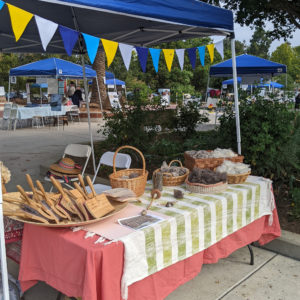
 On September 10th, WSP students and I, their handwork teacher, participated in a Living History event “A Walk Through Time” at the Sunnyvale Heritage Park Museum.
On September 10th, WSP students and I, their handwork teacher, participated in a Living History event “A Walk Through Time” at the Sunnyvale Heritage Park Museum.
Representing the “golden days” of the rancho period, 1833 through 1846 in California, WSP’s booth “Fun with Wool” was a great success. Under the enthusiastic and patient tutelage of WSP students in period costumes and myself, visitors learned through hands-on activities how a sheep fleece is processed into yarn. Guests had an opportunity to card wool, build spindles from rocks and sticks, and spin yarn.
Sunnyvale’s Vice Mayor, Alysa Cisneros, joined the fun with demonstrations using a spinning wheel.
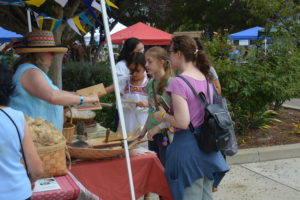
Many thanks to Juli, Sahar, and Anne-Mare in sixth grade; Mascha in eighth grade, and Maia twelfth grade for their wonderful ambassadorship and representation of our school.
Note: Two WSP alumni parents, Katharina Woodman and Kim Thurgate are volunteers at the museum where Kim serves as event coordinator who planned this festival. When Kim was looking for an activity that would tell the story of the sheep pastures and wool processing, Katharina suggested Kerstin and her students, having witnessed them practicing wool processing in handwork class.
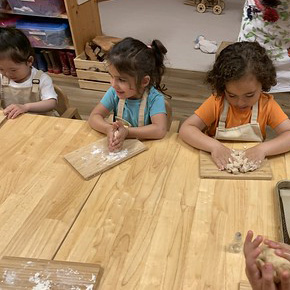
What are the children doing when they bake bread in Early Childhood?
They are:

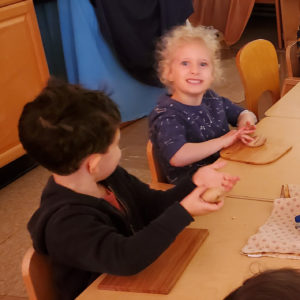 In the Waldorf curriculum, especially at the Nursery School and Kindergarten level, the emphasis is on the process, not the product. Worrying about achieving perfect, smooth loaves would defeat that purpose. The learning is through doing.
In the Waldorf curriculum, especially at the Nursery School and Kindergarten level, the emphasis is on the process, not the product. Worrying about achieving perfect, smooth loaves would defeat that purpose. The learning is through doing.
In the same way, over-explaining the purpose of an activity robs the young child of the chance to explore, discover, and observe on their own. It takes away some of the magic of discovery.
These are just some of the reasons we bake bread as part of the Early Childhood curriculum.